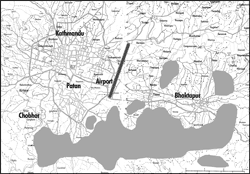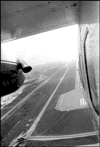 Then the cement factory at Chobhar officially shut down on 14 January, everyone assumed the quality of air in the capital would improve dramatically. After all, Himal Cement had for the past 25 years been pumping soot and cement dust into the valley's atmosphere.
Then the cement factory at Chobhar officially shut down on 14 January, everyone assumed the quality of air in the capital would improve dramatically. After all, Himal Cement had for the past 25 years been pumping soot and cement dust into the valley's atmosphere. The cement factory is gone, but the air quality has not improved. The reason is visible right here below Chobhar hill on any given morning. The factory lies idle, its stack smokeless for once, but across the Bagmati on a picturesque staircase of terrace fields are at least six new brick kilns spewing out acrid black smoke. Across the hill below the swanky new villas at Bhaisepati, and all along the southern outskirts of Patan, a pall of black-grey smog smudges the sky-overnight emission from the furnaces of hundreds of new kilns baking bricks to meet the increasing construction demand of Kathmandu Valley.
The effect of all this smoke is not readily apparent to city dwellers. But in southern Patan residents complain that laundry hanging up to dry, tables and chairs have a veneer of black soot every morning. What this is doing to the lungs of valley residents is anybody's guess.
A study by the environmental group, Clean Energy Nepal (CEN), showed that there are three times higher levels of particulate matter in the air in villages located near brick kilns compared to villages which had no kilns. Although the brick kilns are not the only culprits, environmental activists say that they are emerging as the single biggest cause of particulate pollution in the valley. Old vehicles, adulterated diesel, construction activity, burning rubbish heaps are the other causes.
The kilns are arrayed in an arc from Bhaktapur to Thankot, and night-time emissions here mix with Kathmandu Valley's notorious fog to create a dense grey smog every morning. This cloud of pollution is right on the flight path of Kathmandu airport, and civil aviation authorities say visibility is worse this year than ever before.
"In the past two months, there has been a sharp increase in the number of flight cancellations and aborted landings at this airport," a meteorologist at the Air Transport Support Centre at the airport told us. While he wouldn't speculate on how much of this is due to the brick kilns beyond the end of the runway, he admitted that "poor visibility is greatly exacerbated by high levels of suspended particulate matter in the air".
A captain with Royal Nepal Airlines who flies Boeing 757s says he has never seen it as bad as this winter. "Sometimes the smog does not lift till past noon. And even if the runway 20 approach is clear (from the north) the 02 approach (from the south) is completely covered up." Bigger jets of international airlines all make instrument approaches from the south, but visibility is reduced to below the minimum required for landings because of the brick kiln-induced smog on final approach.
According to a landmark survey in 1996 by the World Bank, the number of days in January with visibility more than 8 km at noon had decreased from 25 days in the 1970s to only five days in 1993. In 2000, this further deteriorated to only two days. Meteorologists now say air quality has got worse in the past year because of the kilns. Flight cancellations are affecting the already crisis-ridden tourism industry, and causing significant losses in revenue for airlines who have to burn more fuel to hold in the air, or make costly diversions to other airports because of poor visibility in Kathmandu.
 The Nepal Environmental and Scientific Services (NESS) regularly measures Kathmandu's air pollution levels, and has identified unscientifically-built kilns as major polluters, burning far too much low-grade coal for the volume of bricks they produce. They are called "bull trench" kilns and have been banned in just about every other country in the region because of their primitive design. Making matters worse is that they burn either low-grade coal, and some even pack tyres and plastic
The Nepal Environmental and Scientific Services (NESS) regularly measures Kathmandu's air pollution levels, and has identified unscientifically-built kilns as major polluters, burning far too much low-grade coal for the volume of bricks they produce. They are called "bull trench" kilns and have been banned in just about every other country in the region because of their primitive design. Making matters worse is that they burn either low-grade coal, and some even pack tyres and plastic waste into the furnaces to get them started.
 In the past year, brick kilns have come up all over the Valley with spectacular speed. The state of emergency and the counter-insurgency operations have driven thousands of families who are scared of being caught in the crossfire to the safety of Kathmandu, (See "People moved by the people's war", #41) and houseowners here are cashing in on the phenomenon by rushing to add floors to their buildings. The Central Bureau of Statistics recorded less than one percent growth in the construction sector last fiscal year, but it is estimated to grow by three percent in 2001/02. The real estate market which had crashed has suddenly picked up in Kathmandu.
In the past year, brick kilns have come up all over the Valley with spectacular speed. The state of emergency and the counter-insurgency operations have driven thousands of families who are scared of being caught in the crossfire to the safety of Kathmandu, (See "People moved by the people's war", #41) and houseowners here are cashing in on the phenomenon by rushing to add floors to their buildings. The Central Bureau of Statistics recorded less than one percent growth in the construction sector last fiscal year, but it is estimated to grow by three percent in 2001/02. The real estate market which had crashed has suddenly picked up in Kathmandu. The building blocks of the construction boom are bricks. And these are baked from the fertile clay and alluvium of the valley floor. Kathmandu bricks that used to sell for Rs 1,700 per 1,000 a year ago now go for twice that. New kilns are coming up every week, and with every new room built, the quality of the capital's air deteriorates.
Visibility and air quality are both far worse in the winter months, December, January and February. Kathmandu's bowl-shaped topography makes it difficult for warm, dirty air to escape because it is trapped underneath a layer of cold air-a phenomenon called temperature inversion. Brick-baking is also concentrated in the dry winter months when farmers rent out their fallow fields to the kilns.
But there are signs of grassroots resistance. In the town of Tikathali in Lalitpur district, locals have lobbied with the government to have seven illegal kilns outside their village banned. In Bhaktapur villagers actually attacked a polluting brick kiln and destroyed the chimney and furnace. The Godavari Village Resort in Kitni is working with the local VDC to find alternatives for nearby farmers who are tempted to rent their fields to kilns in the fallow season.
But although grassroots activism may be growing, the government is plagued by familiar lethargy. For example, the illegal kiln owners in Tikathali have so far ignored the ministry and the Lalitpur CDO office and have refused to even receive letters written by them to close down within 35 days or pay a fine. Still, the fact that locals are worried enough to take action is seen by environmental groups as a good sign.
"The resistance to brick kilns is coming from the grassroots," says Bhushan Tuladhar of Clean Energy Nepal. "They are now much more conscious about the damage that the kilns do to the air and to the fertility of their soil."


